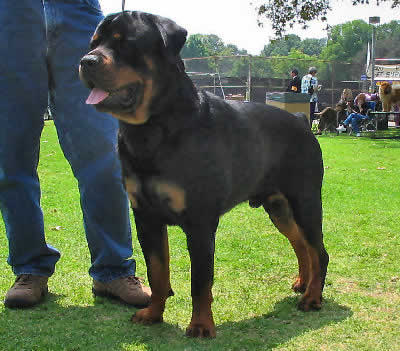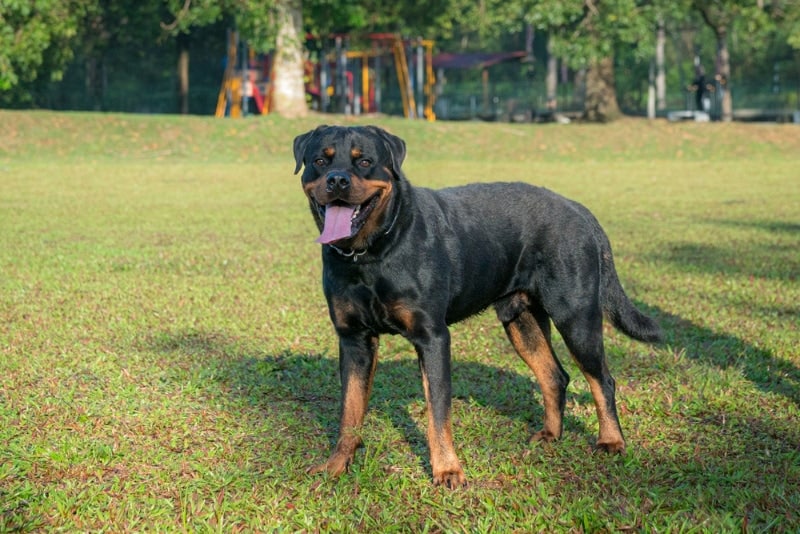
The Rottweiler has a very long history, highly prized and favored as a companion and helper!
With a history dating back to the Roman Empire, the Rottweiler has been used as a herding dog, a guard dog, and a war dog. In more modern times it is a valuable police dog as well. This medium sized muscular dog is classed as working dog breed. It is very handsome, smart and devoted to its keepers.
The Rottweiler is a highly protective dog that will go to great lengths to defend its family. With proper training and socialization the Rottweiler is calm, loyal and loving. They can also get along with other pets if introduced with them while young, This breed does well in obedience and tracking. When selecting a Rottweiler, look for hip and elbow dysplasia, heart disease, and Von Willebrand’s disease.
- Kingdom: Animalia
- Phylum: Chordata
- Class: Mammalia
- Order: Carnivora
- Family: Canidae
- Genus: Canis
- Species: lupus familiaris
Common Name(s)
The American Kennel Club (AKC) describes a set of standards for the Rottweiler, and currently they recognize just one type of Rottweiler. But there are some who suggest there could be two types of Rottweiler, a German Rottweiler and an American Rottweiler. Going beyond where they are born, the German variety is said to have a bigger and more blocky head, with a body that is shorter and stockier. The American variety is then less stocky, longer legged, and has a less blocky head. Although the “German” traits are outside the standards set by the American Kennel Club (AKC), some are working on developing Rottweilers for these “German Rottweiler” characteristics. So we’ll have to wait and see, eventually perhaps two types of Rottweilers become recognized.
Breed Type
A working breed, the Rottweiler is a large, protective dog that has been subject to breed bans in some areas. The Rottweiler has served as a herder, assistant to merchants, and war dog.
Background
The Rottweiler’s history goes back to the Roman Empire. Thought to be a descendent of the Italian Mastiff, the breed was developed in Rottweil, Germany. The Rottweiler nearly became extinct in the late 1800s, but was revived due to increased demand for police dogs in World War I.
Some make distinctions between the American Rottweiler and the German Rottweiler. The German is said to be shorter and more solid with a larger head. The AKC makes no such distinction, but those considered German Rottweilers often fall outside the club standards.
Mutations of the breed include the red Rottweiler, and popular hybrids are the Boxweiler (Boxer and Rottweiler mix) and the English Mastweiler (Mastiff and Rottweiler mix).
Description
Rottweilers are muscular dogs with broad heads and prominent muzzles. Their eyes are dark, their ears triangular, and their noses black. Their short coat is black with brown markings. Males are 24-27 inches tall and weigh 95-130 pounds. Females are 22-25 inches tall and weigh 85-115 pounds.
Care and Feeding
The Rottweiler’s diet should consist of lamb, poultry, wheat and dairy. This breed needs puppy food until it is 1 �½ to 2 years old. Regular brushing is all that is necessary to keep your Rottweiler’s coat in good shape. Baths should be given only as needed. It is customary to dock the Rottweiler’s tail, and to remove rear dewclaws if they exist, at 1-3 days of age.
Annual checkups are advisable. Vaccinations should be given on the following schedule:
- 6-8 weeks: Distemper, Leptospirosis, Hepatitis, Parainfluenza, Parvo, and Corona virus (DHLPPC)
- 10-12 weeks: Second DHLPPC
- 14-16 weeks: Third DHLPPC and rabies
- Annually: DHLPPC and rabies booster
Rottweilers shed moderately. Regular vacuuming is necessary if kept inside.
Housing Your Dog
Rottweilers do not need a large amount of space indoors. A small yard will be enough for them to get the exercise they need.
Social Behaviors
Properly trained and socialized Rottweilers can be trusted around children, friends and relatives. They can get along with other pets if introduced with them while young.
Handling and Training
Training requires a firm hand, but usually goes well if you let the dog know who is in charge. It is crucial that the trainer be able to handle a large, powerful dog effectively.
Activities
Rottweilers need plenty of exercise. They enjoy daily walks or jogs, swimming, and games of fetch. It is important to take care not to overwork them while young, because this can damage their bones and joints. With adults, take care to avoid overheating in hot weather.
Breeding/Reproduction
When selecting a mate for your Rottweiler, it is important to check for hereditary disorders. Ones to look for include joint dysplasia, heart disease, thyroid problems, and Von Willebrand’s disease.
Common Health Problems
Bloat is a concern with Rottweilers. It is important not to overfeed them, and not to exercise them too soon after meals. Extra weight can also contribute to joint problems.
Availability
Rottweilers are easy to find in most areas, but it is important to buy from a reputable breeder. Improper breeding tends to produce puppies with behavior problems. Prices are usually $800 to $1,000 and up.
References
- Liz Palika, The Howell Book of Dogs: The Definitive Reference to 300 Breeds and Varieties , Howell Book House, 2007
- American Kennel Club, The Complete Dog Book: 20th Edition (Complete Dog Book) , Ballantine Books, 2006
- Kristin Mehus-Roe, The Original Dog Bible: The Definitive Source to All Things Dog, BowTie Press, 2005
- Rottweiler, CopyrightDog Breed Info Center
- Welton, Michelle, Rottweilers: What’s Good About ‘Em? What’s Bad About ‘Em?, Copyright 2000-2011
- Rottweiler, Wikipedia
- Rottweiler Puppies for Sale, Copyright PuppyFind.com, LLC
Featured Image Credit: Sinseeho, Shutterstock
